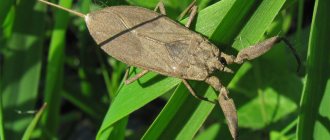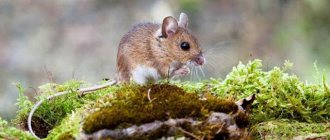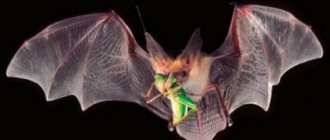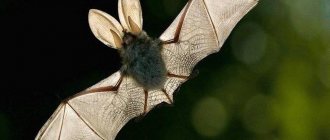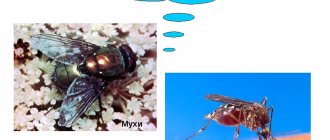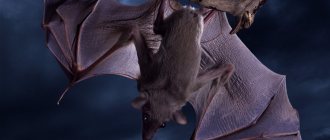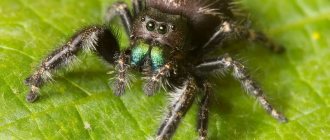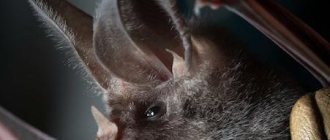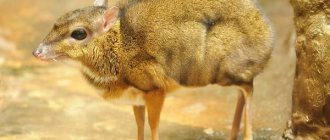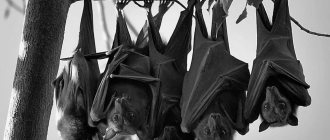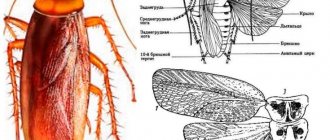Chiroptera - belongs to the class mammals. They are capable of flight thanks to modified forelimbs and use flight as the main method of movement.
Chiropterans and birds are the only representatives of chordates that inhabit the air. At the same time, birds are active during the day, and bats at night, which eliminates competition for occupied space. There is a separate science of chiropterology .
Order Chiroptera - bats
general characteristics
Bats are the only mammals that can fly. There are many differences within the species, including in appearance, lifestyle and size. For example, the smallest species is the hog-nosed bat, its body dimensions do not exceed 3.3 cm, and its weight does not exceed 2 g. The wingspan is approximately 16 cm. The hog-nosed bat is not only the smallest in the order Chiroptera, but also among the ten smallest animals on the planet. The largest representative of the order is considered to be a giant false vampire, its body length is about 40 cm, its wingspan can reach 75 cm, and the weight of a mature individual is from 150 to 220 g.
Within a species, mice differ not only in appearance, but also in the structure of their teeth and skull. These features were formed due to evolution and the way of nutrition. Bats have a heterodont dental system, like other mammals. The dental formula consists of canines, incisors, molars and radicular teeth.
Recommended by topic
Fox Panda Lynx
For example, mice that feed only on nectar, like the long-tongued leafnoses, have elongated bones on the facial part of the skull. This feature allows it to accommodate a long tongue, with the help of which the species extracts nectar from flowers.
Insectivorous varieties, which feed on insects with dense chitinous shells, have larger teeth and longer fangs. With their help, mice can bite and chew solid food. Those species that eat mainly soft insects have less developed teeth.
Mice that eat plant fruits have cheek teeth that resemble mortars and pestles. They do not need sharp fangs; they use their molars to grind fruit pulp.
Vampires differ from other species not only in structure, but also in the number of teeth. This species has only 20 teeth, while others have 38. This difference is again explained by the way they feed. Vampires make a puncture in the victim's skin and attach themselves to the wound. They do not eat insects, fruits or other food, so the remaining teeth are less developed. But the front fangs are quite long and sharp.
Elena
Ask a Question
Question to the expert
How long do bats live in the wild?
The average lifespan depends on the species. In their natural environment, mice live from 4 to 20 years. The maximum recorded age is 33 years.
Most species have large ears, which help bats navigate in space.
The size of the ears and the structure of the nasal projections directly affect echolocation. All species have unique hearing, with the help of which insectivorous and predatory species can hear the rustling of insects' wings or detect their movement under a layer of fallen leaves.
Bats have a tragus. This is a unique cutaneous-cartilaginous growth at the base of the ear. This process greatly enhances hearing and perception.
Mice also have a well-developed sense of smell. Individuals are able to find relatives and cubs only by smell. And also find prey and fruits under a thick layer of foliage. Using their sense of smell, mice can distinguish a stranger or find a mating partner at a distance of several hundred meters.
In contrast to the sense of smell and hearing, vision in bats is rather poorly developed. According to research, mice are color blind and see everything in black and white. But this does not mean that they are blind, it’s just that smell and hearing are more important than the visual picture.
All bats have relatively short bodies.
Most have fluffy fur, but there are completely hairless varieties. The tails also have significant differences, for example, in bagwings the tail is partially hidden in the interfemoral membrane, only a small tip sticks out.
In mousetails, the tail hangs freely behind the back, while in bats, it is completely hidden in the membrane.
During evolution, the forelimbs were transformed into wings, but did not lose their main function. This is why bats are often called chiropterans. The humerus became shorter, and the fingers, on the contrary, became longer. During the formation process, the fingers became a kind of frame for the wing, but the first finger with a rather impressive claw remained free.
With the help of a “free” finger, mice move along tree trunks and move along horizontal surfaces. They also pull, pick out and hold food and prey.
The size of the wings affects maneuverability and speed during flight. The shorter the wings, the slower the animal will fly, but the turning speed and overall maneuverability will be very high.
The highly elongated wings do not allow maneuvering in the treetops, but with their help the bat can develop impressive speed in open space.
Average flight speed is from 11 to 55 km/h. The fastest flyer is considered to be the Brazilian folded lip, which can accelerate to 160 km/h. This makes it the fastest flying creature on the planet.
The hind limbs of flyers also have differences.
Recommended by topic
Pig Arctic fox Cobra
The paws of the bats point with their knees back and move wide apart to the sides. They have not changed like the front ones and have not lost their functionality, but in some species the flying membrane reaches the base of the foot.
Due to the structure of their hind limbs, bats can hang upside down and move along horizontal and vertical surfaces in any direction.
Depending on the species, the body of bats can be completely covered with short or long fur. In some varieties, fur covers the front and hind limbs. In the natural environment, there are at least two hairless species that have only a few hairs left on their bodies.
Fur colors can be the most unusual and depend on the species, lifestyle and habitat. The main colors are dark brown, brown and black with a brown or grayish tint. But there are also white, beige, red and yellow colors.
Where do bats live?
City residents believe that it is impossible to find bats in such an area. In fact, this is not so; bats also settle in big cities, but away from high-rise buildings and high-rise buildings.
Where do bats live:
- They can be found in forest belts, near water bodies. There are a lot of insects in such places, so there is a lot of food for mammals. If in summer it is quite difficult to find animals in a big city, then closer to autumn they can fly near high-rise buildings.
- Closer to winter, these mammals look for places where they can take shelter and hide from the frost. Therefore, they are often found under window sills and often fly into apartments to hide from the cold. They prefer to spend the winter in ventilation hatches, or hide on the roof, between the slabs of houses.
- Without food, an individual that feeds on insects can live a long time. The trouble is that a large amount of moisture is lost through the wings. Even if there is no food, it is necessary to have a source of water nearby. In this case, she can live quite a long time. Otherwise, its wings dry out and the mammal dies.
On the rocks
Habitat
Bats inhabit almost every corner on earth.
The exceptions are Antarctica, the Arctic and some parts of the continents, where the temperature does not rise above zero during the year. Another exception is oceanic and sea islands. But the bats simply could not get there. Scientists believe that if animals are taken to the islands, they will calmly take root and reproduce.
The largest populations are recorded in subtropical and tropical forests. Bats like warm climates and plenty of food. The warmer it is, the more insects, ripe fruits and pollen, and therefore food for growing colonies.
What do they eat?
Bats can be roughly divided into insectivores, herbivores and bloodsuckers. Some species feed exclusively on insects or nectar and fruits. Others may combine two types of nutrition. For example, piscivores, in addition to insects and fruits, can eat small fish and crustaceans.
Blood-sucking species or vampires feed on the blood of wild and domestic animals. They make small punctures in the skin and suck blood.
Poll: What did you like most about bats?
They are quite interesting creatures.
0%
I liked their unusual appearance.
0%
I liked the miniature mice, the size of a large insect.
100%
They have an interesting lifestyle and specific behavior.
0%
I didn't like the bats.
0%
Voted: 1
How to attract a bat at home?
A bat flying into a house causes hysterics, as well as the reading of prayers among elderly residents of the apartment. This animal is associated with black magic, so there are many signs regarding the animal flying into the house. You can find out about them in the article “A bat flew into an apartment or house: a sign .
How to attract a bat at home:
- It is necessary to get rid of and catch the animal. To do this, it is advisable to use humane methods, that is, those that do not lead to the death of the mammal. There is no need to kill the animal.
- Please note that these animals are carriers of rabies and a large number of viruses. To protect yourself from infection, you need to wear gloves and contact the animal using a towel or cloth.
- On the street, bats are caught using nets or white cloth. Chiropterans are nocturnal animals; they react quite aggressively to white light and fly towards it.
Animals
cause a lot of trouble to people involved in agriculture, and not at all because they drink the blood of animals. This mammal is a carrier of rabies and other infections. It is noteworthy that vampire bats themselves are immune to rabies, and therefore are insensitive to it. They most often live in flocks; they also prefer to bite prey in company, not alone.
Lifestyle and character traits
Almost all species are crepuscular or nocturnal. But in the natural environment there are species that can be active during the day.
Lifestyle
Some species of bats prefer a solitary lifestyle or gather in groups of 4–7 individuals.
But most species live in colonies and often combine with other species to form large settlements.
Females of the great bat gather in colonies of a thousand or more white individuals. It is noteworthy that there are practically no males in this group, as they prefer to stay alone. The largest colonies of bats are recorded in Brazil. Scientists managed to find a record number of individuals in one of the caves. Brazilian folded lips have gathered into a colony of 20 million individuals.
Bats prefer to sleep in a secluded shelter during the day. For their days, they choose caves, crevices, old hollows in trees, abandoned adits and quarries. Mice are not afraid of people and often live in barns, attics and other buildings.
Small species hide in cracks, climb under bird nests or under the bark of trees.
In some species, daytime shelters are located in rather original places. For example, in a spider's web or in an empty bamboo trunk. American suckerfoots shelter from sunlight in rolled banana leaves, and construction leaf-noses nibble on palm leaves to build a canopy.
Character and habits
Bats do not quarrel with each other and do not start fights for food and territory. Even different species can safely share one shelter.
During sleep and hibernation, mice hang upside down, clinging to any unevenness with their hind limbs.
Some species, such as night bats, when resting, wrap themselves in their wings and try to press closer to each other. Others, on the contrary, try to sleep away from their brothers.
Surprisingly, if during winter sleep a mouse falls from its place for some reason, it will simply freeze.
Although in wintering caves the temperature drops below zero, individuals hanging upside down calmly tolerate sub-zero temperatures.
Question to the expert
How do bats winter? Do they hibernate?
Only those mice that live in temperate latitudes hibernate. They gather in groups and press their bodies closely against each other. During winter sleep, metabolism and biological processes slow down so much that the fliers can be mistaken for dead. Some species do not hibernate, but migrate like birds to warmer climates. Tropical species do not hibernate and lead a normal lifestyle.
Relationships with people
Many people have a negative attitude towards chiropterans: not really knowing what bats eat, and having heard a variety of stories about their bloodthirstiness, they are afraid of them and kill them whenever possible, not even knowing that bats are beneficial both for nature and for person, incredibly tall.
For example, in countries that are located in temperate latitudes, only species live that feed exclusively on insects, bringing considerable benefits. According to scientists, forest growth in Russia is accelerated by ten percent due to the destruction of harmful insects by bats. Since insects are often carriers of various diseases dangerous to humans, thanks to the active hunting of bats, the risk of contracting a dangerous disease is significantly reduced.
Reproduction and raising of offspring
On average, baby bats become sexually mature at one year of age. They are ready to mate and procreate the very next year after birth.
Mating season
The mating season depends on the habitat of winged mammals.
Tropical varieties reproduce twice per season. Residents of temperate latitudes organize mating games in the fall before hibernation.
Duration of pregnancy and childbirth
After mating, the sperm “freeze” and remain throughout the winter. In early spring, they “awaken” and fertilize the egg. The timing of gestation depends on temperature and climate. The warmer it is, the faster the embryo will develop. On average, the duration of pregnancy is from 25 to 40 days.
Babies are born blind, deaf and naked. The weight of mice in some species does not exceed 1g.
The number of cubs in a litter is from 1 to three and depends on the species. For example, ordinary long-eared bats give birth to one baby at a time; leather bats or bats can give birth to 1 to 2 babies. And in litters of hairy tails there can be 3 mice.
Caring for the Cubs
After birth, babies feed on mother's milk and grow very quickly.
By the end of the first week, the weight of the pups doubles, and the body is completely covered with fur. In the second week, their eyes open and hearing appears.
Bats are caring mothers even when the babies grow up. take them with them hunting. The cubs cling to the mother's fur and accompany her on flights, but do not take part independently. Within a month they can hunt next to their mother’s nest.
How long does a bat live?
Babies' eyes open at 5-10 days. At first they are completely hairless, the weight of the cub is half the weight of the mother. After about 3-5 weeks, the baby takes its first flight. Under the strict guidance of his mother, he learns to hunt and get his own food. Usually babies are considered mature at the age of four months. They live approximately 5-10 years. Some individuals can live 12 years at home. But this is only if there is a place to fly and good food. They can fly quite far, covering approximately 50 km per day.
Natural enemies
Bats have practically no enemies, since no one deliberately hunts them.
But many large nocturnal birds are not averse to feasting on quick prey. Mice can also be eaten by snakes, weasels, ferrets or martens. But the damage to the population from natural enemies is so small that it is not taken into account by statistics.
The greatest harm to populations comes from destructive human activity. Every year, the areas suitable for mice to live in are shrinking. Many flyers die due to chemical treatment of fields, fires and deforestation.
Flight
The arm with the wing is driven by several paired muscles of the upper girdle, which, to reduce energy consumption for flight are attached not to the sternum, but to the fibrous base of the wing. The keel of the sternum of animals is inferior in power to that of birds: only one muscle necessary for flight is attached to it - the pectoralis major.
The flight speed of animals usually does not exceed 20 km/h . The record holder is the Brazilian folded lip: its flight speed reaches 100 km/h. Some species are able to fly away for the winter , covering more than 300 km . Read about how bats winter.
The spine of flying mammals is more mobile than that of birds . It allows mice to be more maneuverable outside the air.
Interesting Facts
Despite many years of research into the species, many facts about bats still remain a mystery. Yes, and known information can surprise or shock ordinary people.
Interesting Facts:
- Regardless of the location of the shelter, bats always fly to the left side of the entrance.
- Bats have a fast metabolism, so they must eat a lot and often. For example, an average-sized mouse can eat about 600 mosquitoes per night. If translated into human standards, then such a portion will be equal to 20 pizzas.
- During World War II, there were attempts to use folded lips as carriers of explosive shells. A small bomb was attached to the winged “saboteurs” and released over enemy territory. The timer went off when the frightened mouse hid under the roof of the house. The bomb exploded, and the mixture set fire to garbage and other rubbish in the attic.
- Flocks of bats accompany wild and domestic herds that roam the pastures. Small but agile mice eat insects that annoy animals at night.
- Substances contained in vampire saliva prevent blood clotting. Based on these substances, scientists have developed a drug for blood clots to prevent strokes.
- In European mythology and culture, bats are associated with dark forces. And in China, night flyers are positive animals that bring joy and happiness.
- Bats destroy mosquitoes and other blood-sucking insects in large numbers. An important fact is that winged orderlies eat sleeping colonies of mosquitoes that have not yet begun to reproduce. According to research, killing a dozen sleeping insects is more effective than killing 1,000 flying bloodsuckers.
- Only small species prey on mosquitoes; larger insectivores prefer larger food sizes. They eat many dangerous garden and garden pests. They even build special daytime shelters in agricultural fields to lure night hunters.
- All bats, with the exception of vampires, feed on plant foods, fish and insects. They are non-aggressive and never attack people.
- Vampires prefer to avoid humans and hunt exclusively animals.
- Stories about mice attacking or getting tangled in a person's hair are myths based on subconscious fears. Flyers have a perfect echolocation system, so they can accidentally fall or crash into a person only if they themselves are on the verge of death.
- Despite the fact that mice are not inherently dangerous and do not attack people, they pose a real threat. The thing is that they can be carriers of dangerous diseases and are often carriers of the most terrible viruses.
- Species that feed on pollen and fruit pollinate plants along with insects. They also spread seeds and spores.
- Bat droppings (guano) are a source of nitrogen and phosphorus. Mice excrement is used industrially to fertilize crops.
How do bats navigate in the dark?
Bats navigate in space using echolocation (reflected sound waves). The human ear is unable to detect ultrasound, so many people believe that mice can only squeak.
Depending on the species, animals reproduce sound differently.
Some use their mouth, others use their nose. Mice that emit sound waves through their nostrils have curious projections on their noses that help focus the signal.
Ultrasound reaches the object and the mouse “hears” the reflected waves. This signal is so accurate that flyers can identify an object no larger than 0.1 mm in size and even recognize its density. Using echolocation in complete darkness, winged hunters not only “see” their prey, but can also calculate its speed. When approaching prey, mice make sounds at an incredible speed of up to 250 screams per second.
Some insects have learned to “deceive” the echolocation of bats. At the first sign of danger, the insect sits on a branch or falls to the ground like a stone. This disrupts the fine tuning, the reflected waves are “blurred”, showing the overall picture.
Nocturnal lifestyle of bats
These bats live in dark places and go out to hunt only at night. In rare cases, whole flocks can fly out during the daytime, preferably in the late afternoon. In most cases, if it is not a vampire mouse, they feed on small insects.
They can sleep under cacti, burrow in caves and under stones. The hunt begins at night. They navigate and find their prey using ultrasonic parameters, thanks to their echo location. Some night moths have the ability to deflect ultrasonic waves so as not to become a victim of the animal. This is a unique phenomenon due to which animals cannot detect a mole cricket, even using their location abilities.
Night predator
